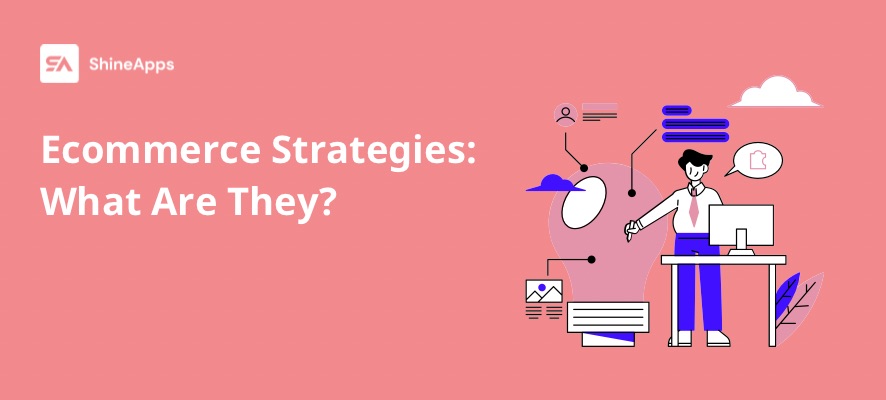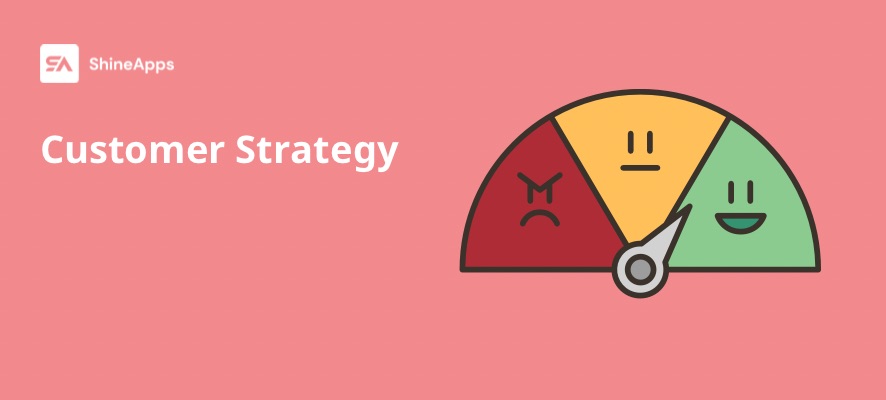Ecommerce strategies are what identifies how you propose to do the following to stand out from the competition and achieve your business goals:
- Increase your audience
- Attracting paying consumers from website visitors
- encourage repurchases
- Increase brand awareness online
Not sure about where to begin?
In this guide, we’ll go over every step of setting up an ecommerce strategy, from identifying your target audience to developing an online store that performs well to creating engaging product descriptions to improving customer trust in your brand.
Ecommerce Strategies: What Are They?

Ecommerce strategies are a collection of tactics created to help you create an effective online business and reach your business growth objectives. These strategies could consist of:
- Doing market and audience research
- Setting up targeted campaigns
- Creating and improving a website
- Data analysis for customers
Even though e-commerce strategies change for each business, the overarching objectives are frequently rather similar: grow your customer base, increase the number of things you sell, and boost your revenue.
You must therefore develop a successful plan. But before you get started, you need to think about issues in three important parts of your company:
- Product strategy
- Customer strategy
- Corporate strategy
Product Strategy

A product strategy is a high-level plan that outlines the unique selling points of your product and your goals for it. You should take into account several elements before developing a product strategy, such as:
Research and Development
Identify who, what group, or what division is in charge of performing product research and development within your business. Research and development may need to be outsourced to a third party if you lack the internal capabilities or funding to complete it.
Target Market Analysis
No matter the industry, it is challenging to develop a successful product. For example, in the CPG industry, only about 3% of new products meet the requirements for extremely successful launches.
Lack of understanding of the intended market for the product is among the most frequent causes of failure. What do they need from a product like yours and who are they? And do they have the money to pay for it?
To understand how your items better fit the needs of your target market, think about doing a SWOT analysis.
Inventory Supply Chain
For online stores of all kinds, supply chain problems are a problem. According to research from Jungle Scout, 42% of large brands and 27% of small business owners have previously been unable to order new goods from suppliers. These delays frequently continue for several months.
It’s important to think about where you’ll get your ingredients and supplies or, if you’re not making the product yourself, every single thing.
Is there any “wiggle room” in your planned strategy to handle shortages without significantly impacting your bottom line? And how long will it continue to be profitable?
Lines Of Products
If you only sell one product, developing a product strategy is rather straightforward.
Sadly, a great deal of online stores provide dozens, hundreds, or even thousands of different products.
When creating your product strategy, you must consider every part of your range. For example, a clothing business should decide whether to allow consumers to customize orders by, for example, selecting the logo they want on a T-shirt.
Product Viability
Running shoes are an example of an evergreen product that consumers may purchase at any time of the year. Others, like sunscreen, are seasonal and have a certain window of opportunity for sales.
Both are suitable choices. However, it might make sense to think about offering a mix of year-round and seasonal products to help you generate regular revenue all year and profit from important shopping holidays like Christmas and Valentine’s Day.
Competitive Landscape
No e-commerce business exists in an empty space. You must recognize your major competitors, determine their advantages and disadvantages, and decide how to “win” against them if you want to survive and grow.
Identifying the reasons a consumer would choose to do business with you over your competitor is your main objective at this point. What makes you an attractive proposal, in other words? You might be the one:
- Pricing
- Customer service
- Shipping duration
- Product range and quality
- Sustainability of the product
Maybe something is quite different. But once you know what it looks like, you can concentrate on using marketing and promotions (we’ll talk about those later) to spread your important messages.
Customer Strategy

The specific value and experience you offer to a particular group of customers over a specific time frame is your customer strategy. This brings together several threads, including your go-to-market strategy and the way you segment and target customers in marketing campaigns.
When planning your customer strategy, keep the following important factors in mind:
Target Audience
Who are you trying to reach, to put it simply? Many businesses combine this data to create one or more buyer personas that address particular characteristics and qualities, like:
- Goals and interests
- Pain points
- Buying power
Sales Channels
Most ecommerce businesses use a variety of sales channels, including social media, email marketing, and pay-per-click advertising, to reach and convert new customers.
Based on the media tastes and online habits of your audience, which channels make the most sense for your store?
Company Branding
Your name, logo, and tone of voice are all part of your branding, which is how you present yourself to customers.
Although some businesses view this as a nice-to-have rather than a crucial component of their e-commerce strategy, strong branding offers real advantages.
Customer Retention
Your ecommerce strategies should put a lot of focus on customer retention. Understand your current retention rate and purchase frequency using your existing customer data or market analysis, and think about how both might be improved.
Customer Experience and Usability
If done correctly, customer experience and usability can become important brand differentiators. You must take into account everything, from ease of use to customer support, to achieve that.
Corporate Strategy

A corporate strategy is a long-term plan that outlines how you’ll outperform your competitors and provide value to your stakeholders and customers. When creating your corporate strategy, take into account the following factors:
Financing
Running out of money is the second most frequent cause of startup failure.
As a result, you must take your financial situation into account while developing a corporate plan, including how much money you’ll need to start and how much more you’ll need to reach your growth objectives.
You should also consider other funding options, such as Shopify Capital or a line of credit with a different institution.
Human Resources
Your human capital will be crucial to the success of your e-commerce business unless you’re a one-person operation. You need a strong HR strategy that takes into account the following considerations to attract and keep the best employees:
- Salary and bonuses
- Employee benefits
- PTO
- Continued professional development
- Disciplinary procedures
Management of Risk
One in four businesses fails to reopen after a disaster, so you should prepare for them by creating a cybersecurity strategy and identifying who is in charge of adhering to laws and regulations. Once more, if you lack the necessary knowledge and skills, think about employing a third party to assist you.
Shareholders
You may never have to consider shareholders or you may have to deal with them very soon, depending on how long you’ve been in business and your future objectives.
You need a strategy for handling any external investors you may have, even if you don’t have shares. That includes considering when and how often you’ll communicate with them and how you intend to repay their investments over time.
In Conclusion
Many companies make the mistake of considering a strategy paper as a one-time task.
The truth is that the most successful e-commerce strategies are never done because they are always changing to take into account new product releases, shifting consumer tastes, and other factors.
To make sure your plan remains relevant to the demands of the business you run, take the time to evaluate it frequently and make revisions as necessary.



